Geothermal energy, often considered Earth's hidden power source, harnesses the planet's internal heat, which can exceed 5,000°C at the core, offering immense potential for sustainable energy. Currently, it accounts for less than 1% of global energy production, yet only 6.9% of its capacity has been tapped. This energy is extracted through various technologies, including dry steam, flash steam, and binary cycle systems, with Enhanced Geothermal Systems (EGS) further expanding our options. With a global capacity reaching 15.4 GW by 2019, geothermal energy presents significant opportunities for emissions reduction and economic stability, especially in volcanically active regions where climate initiatives are essential. We'll explore this further.
Key Takeaways
- Geothermal energy harnesses Earth's internal heat, providing a stable and renewable energy source for electricity generation.
- It has vast untapped potential, with only 6.9% of geothermal resources currently utilized worldwide.
- Geothermal power plants produce significantly lower carbon emissions compared to fossil fuels, aiding in climate change mitigation.
- Enhanced Geothermal Systems (EGS) expand access to lower temperature resources, increasing geothermal energy's viability and scalability.
- Despite its advantages, geothermal energy remains underdeveloped due to high initial costs and geological risks.
Understanding Geothermal Energy
Geothermal energy is a fascinating renewable resource that taps into the Earth's natural heat. By harnessing the Earth's internal heat, which can exceed 5,000°C at the core, we can produce sustainable energy. Geothermal power plants, utilizing hot water and steam, are primarily categorized into dry steam, flash steam, and binary cycle systems, each tailored to specific temperature and resource conditions. Enhanced Geothermal Systems (EGS) further enhance our ability to extract energy from low-pressure areas through hydraulic fracturing techniques. Despite geothermal energy accounting for less than 1% of global energy production, its potential remains vast, especially in regions with high volcanic activity. This renewable energy source plays a significant role in climate mitigation, offering a pathway toward cleaner electricity generation for our future.
Historical Milestones in Geothermal Development
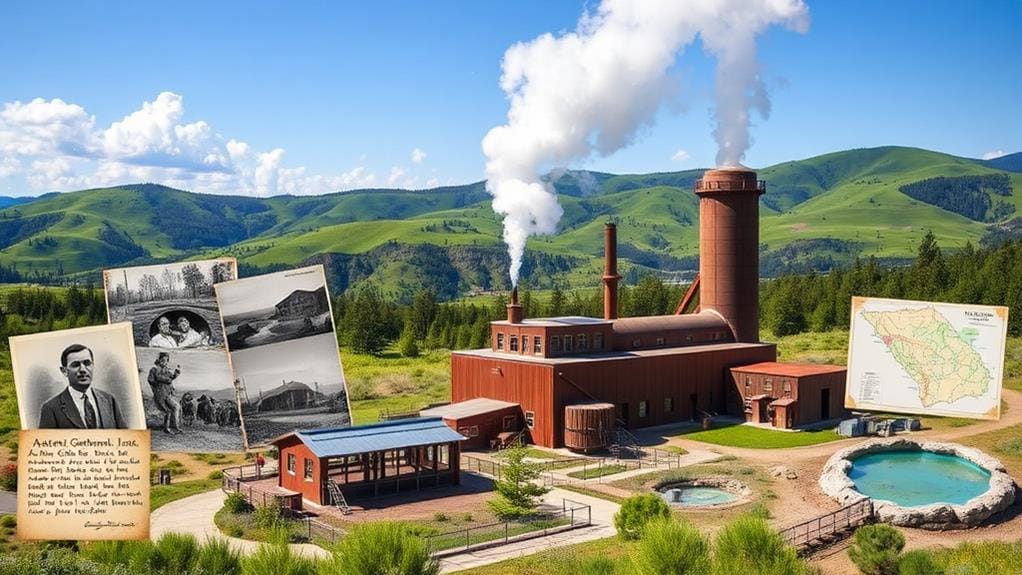
The journey of harnessing geothermal energy has been marked by significant milestones that showcase our growing understanding and technological advancement in this field. It began with the first geothermal power generator tested in 1904 in Larderello, Italy, which led to the establishment of the world's first commercial geothermal power station in 1911, maintaining its status until 1958. In 1958, New Zealand's Wairakei station became the first to utilize flash steam technology, promoting efficient geothermal electricity production. The United States joined in 1960 with The Geysers in California, the first successful geothermal power station in the country. Finally, the development of binary cycle technology in 1967 expanded our ability to harness lower temperature geothermal energy resources, marking another leap in renewable energy innovation.
Global Geothermal Resources and Capacity

As we explore global geothermal resources and capacity, it's crucial to recognize the significant distribution of geothermal potential across various regions, particularly in countries like Indonesia, which boasts the largest estimated potential at 29 GW. While the global geothermal power capacity reached 15.4 GW by 2019, with the United States contributing a notable 3.68 GW, we must also consider the capacity growth trends that indicate a promising future for this renewable energy source. By examining current generation statistics and potential estimates—which suggest a range between 35 GW and 2000 GW—we can better understand the opportunities that lie ahead in harnessing geothermal energy.
Geothermal Resource Distribution
Across the globe, geothermal energy resources present vast potential for sustainable power generation. The current global geothermal capacity stands at approximately 15.4 GW, with the United States contributing 3.68 GW, reflecting its significant role in geothermal electricity generation. Indonesia boasts the largest geothermal potential, estimated at 29 GW, yet only 1.8 GW was installed by 2017. Countries like El Salvador, Kenya, and Iceland generate over 15% of their electricity from geothermal sources, highlighting diverse geothermal resource distribution. Despite the estimated geothermal electricity generation potential ranging between 35 and 2000 GW, only 6.9% has been tapped, emphasizing the need for further development. Harnessing geothermal heating can play a pivotal role in climate mitigation and expanding renewable energy options.
Capacity Growth Trends
Geothermal energy has shown promising growth trends, reflecting its potential to expand considerably in the coming years. As of 2019, global geothermal power capacity reached 15.4 GW, with the U.S. contributing 3.68 GW, showcasing our collective commitment to renewable energy. Projections indicate that global geothermal capacity could increase to between 14.5 and 17.6 GW by 2020, yet only 6.9% of total geothermal potential is currently tapped. Countries like Indonesia, with a staggering 29 GW potential and 1.8 GW installed capacity, highlight significant growth opportunities. Additionally, nations such as El Salvador and Kenya derive over 15% of their electricity from geothermal sources, emphasizing the technology's ability to meet sustainable energy needs. With increased investment levels and technological advancements, geothermal electricity generation could ultimately reach between 35 and 2000 GW.
Types of Geothermal Power Stations
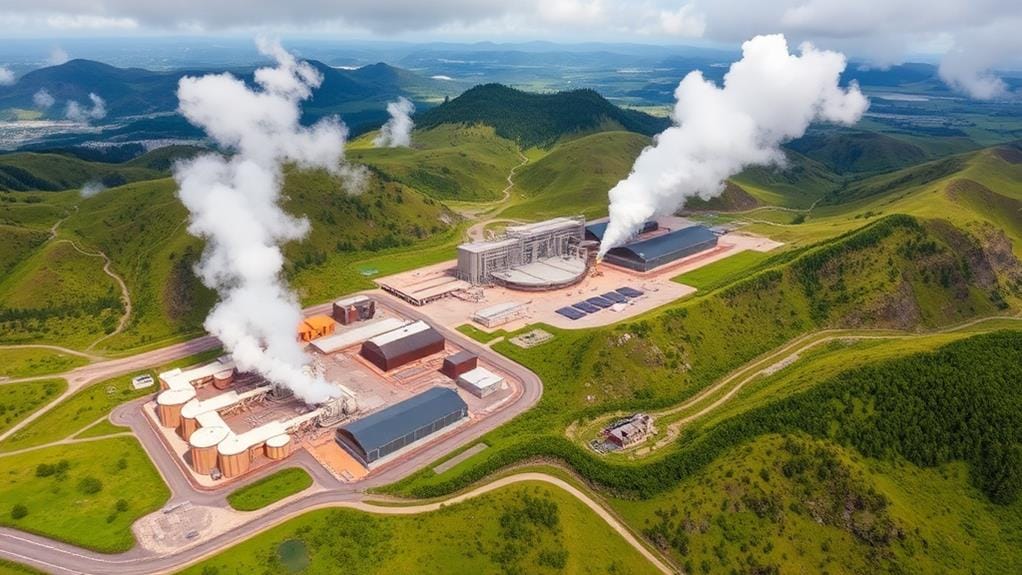
When it comes to harnessing geothermal energy, we have three main types of power stations: dry steam, flash steam, and binary cycle. Dry steam power plants are the oldest design, directly using steam from geothermal reservoirs to drive turbines, requiring temperatures of 150°C or higher. Flash steam power plants convert high-pressure hot water, at least 180°C, into steam in lower-pressure tanks, allowing the steam to produce electricity. Conversely, binary cycle power plants utilize geothermal heat from lower temperature resources, as low as 57°C, by employing a secondary fluid with a lower boiling point to vaporize and drive turbines. Additionally, Enhanced Geothermal Systems (EGS) can stimulate production in areas with less pressure, broadening the scope of renewable energy generation.
Environmental Benefits of Geothermal Energy
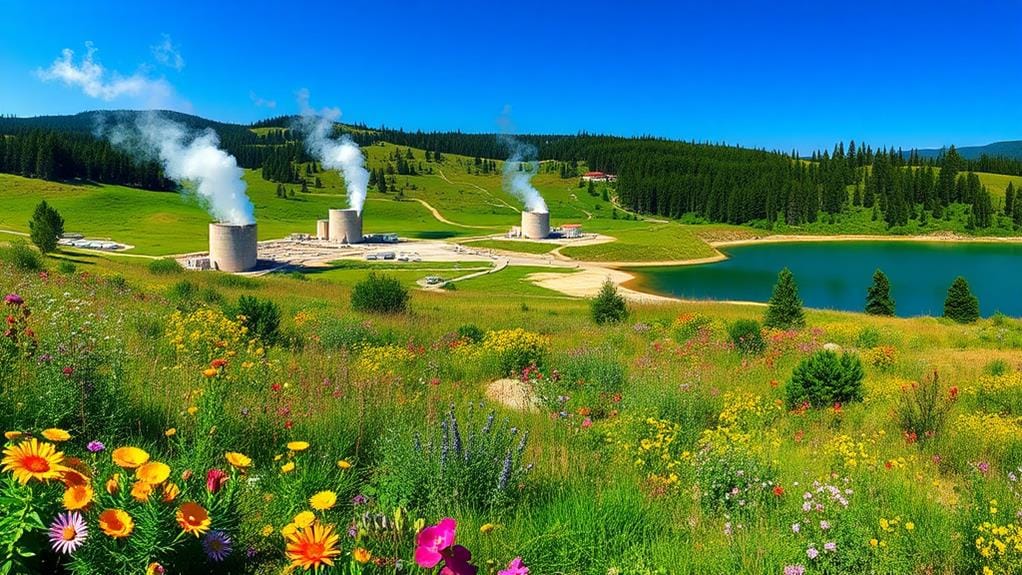
Harnessing geothermal energy offers remarkable environmental benefits that contribute to a sustainable future. As one of the cleanest energy sources available, it produces an average of just 45 grams of CO2 per kWh, which is less than 5% of the emissions from coal-fired plants. Geothermal power plants require considerably less land per kilowatt produced compared to other renewable and fossil fuel sources, minimizing their environmental footprint. The extraction of geothermal energy is sustainable, drawing from the Earth's vast heat content, ensuring long-term availability. In addition, by reducing reliance on fossil fuels, we can achieve climate cooling and lower greenhouse gas emissions. Locations like Iceland and New Zealand demonstrate reduced carbon footprints, showcasing the profound environmental benefits of geothermal energy.
Economic Factors and Investment Risks
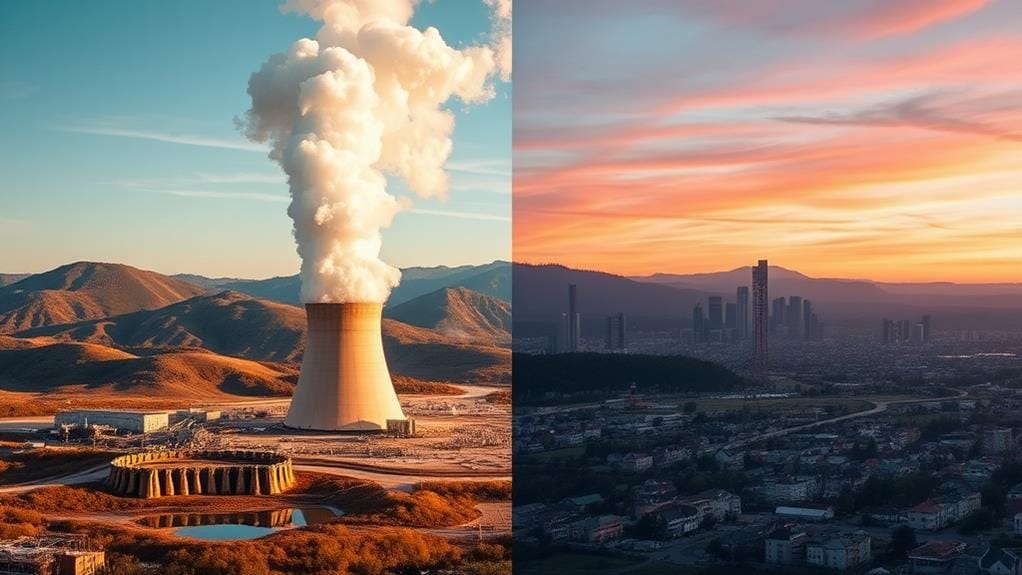
As we explore the economic factors and investment risks associated with geothermal energy, it is crucial to acknowledge that the initial capital investment, particularly the substantial drilling costs which can exceed 50% of total project expenses, poses a significant barrier for new entrants. However, the long-term economic benefits, including a stable levelized energy cost ranging from €0.04 to €0.10 per kWh, coupled with job creation and local tax revenue generation, can provide compelling advantages that offset these initial hurdles. Nevertheless, we must also consider the inherent risks, such as land stability concerns and the potential for induced seismicity, which require careful management and due diligence in the investment process.
Initial Capital Investment
Geothermal energy presents a substantial initial capital investment, often exceeding $5 million per megawatt of installed capacity. This significant cost primarily arises from drilling costs, which can account for over 50% of total expenses. While the levelized cost of electricity (LCOE) ranges from €0.04 to €0.10 per kWh, offering a predictable financial outlook, we must also consider the investment risks involved. Challenges such as land stability issues during construction, potential induced seismicity from Enhanced Geothermal Systems (EGS), and the handling of trace toxic chemicals in geothermal fluids can complicate projects. Additionally, volcanic activity, as seen with the Puna Geothermal Venture in Hawaii, poses operational challenges that can impact energy independence and job creation in local economies.
Long-Term Economic Benefits
Investing in geothermal energy can yield significant long-term economic benefits that extend beyond mere electricity generation. While initial capital investments may be high, especially with drilling costs exceeding 50% of total expenses, the operational costs are exceptionally low thereafter. This creates a favorable levelized energy cost ranging from €0.04 to €0.10 per kWh, ensuring stability against fluctuations in fuel prices. Additionally, geothermal projects contribute to job creation and stimulate local economies, enhancing energy independence. However, we must also consider the risks associated with these investments, including potential land stability issues and volcanic activity, evidenced by the Puna Geothermal Venture's challenges post-2018 eruption.
| Benefit | Description |
|---|---|
| Job Creation | Generates local employment opportunities |
| Stability Against Fluctuations | Provides predictable energy costs |
| Capital Investments | Initial costs lead to long-term savings |
| Energy Independence | Reduces reliance on imported fuels |
Future Potential of Geothermal Energy
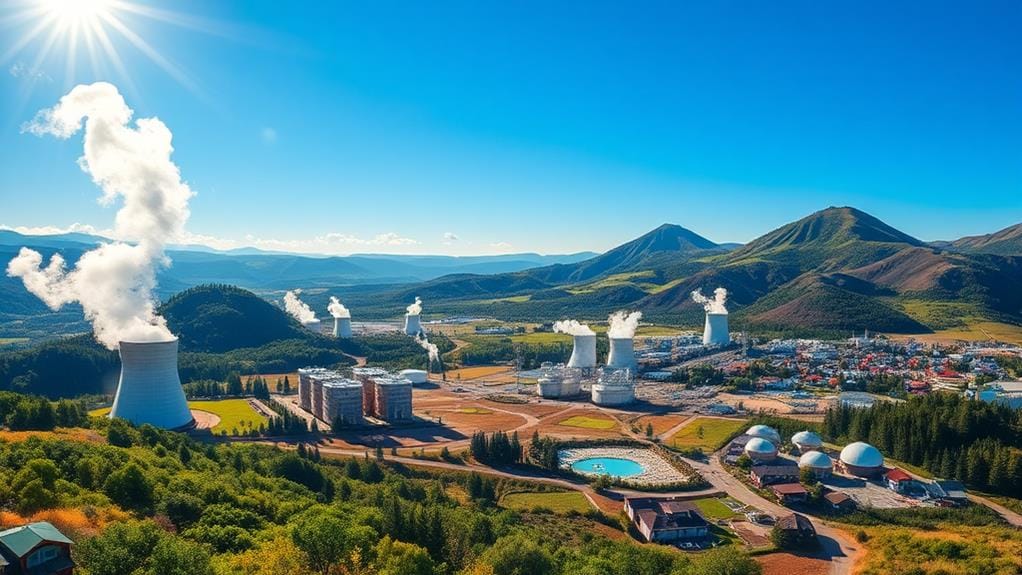
Harnessing the immense potential of geothermal energy, we stand on the brink of a significant shift in our global energy landscape. The International Energy Agency (IEA) anticipates that geothermal energy could contribute up to 3.5% of global electricity generation by 2050, marking a pivotal opportunity for growth. Enhanced Geothermal Systems (EGS) expand our reach, allowing us to tap into untapped resources in various regions, potentially increasing global geothermal power capacity from 15.4 GW to an estimated 2000 GW. As technology advancements continue, including enhanced drilling methods and binary cycle systems, we can maximize efficiency and drive energy independence. This progress not only supports renewable energy initiatives but also fosters sustainable development, particularly in developing countries rich in geothermal potential.
Geothermal Energy Around the World

As we explore the future potential of geothermal energy, it's important to recognize how different countries are leveraging this resource today. Countries like Iceland utilize geothermal energy for about 25% of their electricity generation, showcasing its effectiveness in renewable energy portfolios. The United States leads globally with an installed capacity of nearly 3.8 GW, primarily concentrated in California, Nevada, and Hawaii. Meanwhile, New Zealand's Wairakei Power Station has been a cornerstone since the 1950s. In Africa, Kenya geothermal energy initiatives, particularly the Olkaria Geothermal Plant, play a crucial role in their energy strategy. Indonesia, despite its vast geothermal potential of 29 GW, had only 1.8 GW installed by 2017, highlighting both challenges and opportunities in harnessing Earth's natural heat.
Frequently Asked Questions
Why Is Geothermal Energy Untapped?
Geothermal energy's untapped potential stems from insufficient resource assessments, high drilling technology costs, and inadequate infrastructure. We need better geological surveys, economic feasibility studies, and policy incentives to enhance energy efficiency and minimize environmental impacts together.
Why Is Geothermal Energy Not Available Everywhere?
Imagine a treasure map; geothermal hotspots are the X marks the spot. Yet, without advanced drilling technology and supportive government policies, we can't access their potential. Together, we must advocate for better energy infrastructure and resource management.
Why Is Geothermal Energy Such a Limited Resource?
We recognize geothermal energy's limitations stem from resource availability, location dependence, and high drilling costs. While its renewable potential is vast, environmental concerns and infrastructure investment challenges hinder its widespread adoption and energy efficiency.
Why Does Geothermal Energy Exist in the Earth?
Geothermal energy exists due to geothermal heat from underground reservoirs, enhanced by tectonic activity and magma chambers. In volcanic regions, thermal conductivity and geothermal gradients create hydrothermal systems, enabling sustainable energy extraction for all of us.




